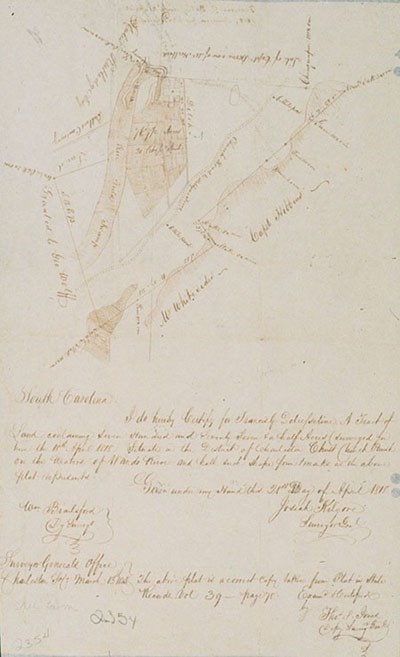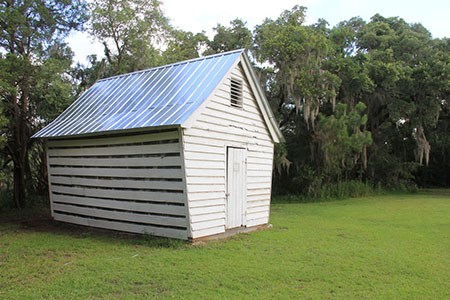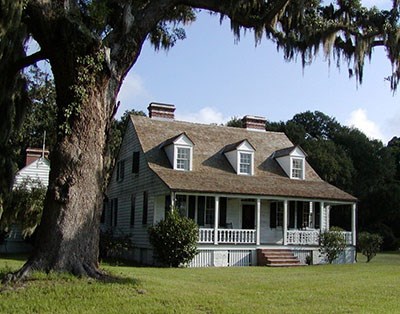Last updated: May 21, 2019
Article
Naturalization at Charles Pinckney National Historic Site

NPS Image
Gary Stansberry, former acting superintendent of Charles Pinckney National Historic Site, noted during the October ceremony that, “Charles Pinckney’s role in framing the U.S. Constitution make this site an appropriate place to welcome new citizens into this country and to reflect on the meaning and responsibilities of citizenship.”
Naturalization ceremonies have been held on the grounds of Snee Farm since 1997. The most recent ceremony hosted 100 individuals from 44 countries that were sworn in by U.S. District Court Judge, Richard Gergel. Each individual announced their name and country of origin and recited the Oath of Allegiance. During the ceremony, the Citadel Color Guard performed “Retiring of the Colors,” and a local student led the Pledge of Allegiance.
Naturalization is the process by which citizenship is granted after an individual fulfills the requirements established by Congress in the Immigration and National Act. Naturalization ceremonies are formal proceedings in which foreign citizens or nationals are sworn in as United States citizens and receive their Certificate of Naturalization. The ceremony and oath of citizenship are the final steps in the long process of becoming a citizen.
"These magnificent places belong to all Americans..."
Since 2006, the National Park Service has partnered with the United States Citizenship and Immigration Services to host naturalization ceremonies in parks throughout the country. The partnership was renewed in 2010, and over 100 ceremonies were held in 2016, the NPS centennial year, welcoming the country’s newest citizens in national park sites.
Naturalization ceremonies held at NPS sites celebrate new citizens in the natural and cultural heritage sites that embody the broad and varied history of the United States. While recognizing our collective history, each new citizen adds their own stories to the continuously unfolding narrative of the country.
Naturalization ceremonies held at NPS sites celebrate new citizens in the natural and cultural heritage sites that embody the broad and varied history of the United States. While recognizing our collective history, each new citizen adds their own stories to the continuously unfolding narrative of the country.
Former NPS Director Jonathan Jarvis commented in 2016, "National parks tell the stories of notable people, great achievements, and monumental events that shaped our nation, our government, and our society. These magnificent places belong to all Americans and we invite everyone, especially our newest citizens, to Find Your Park."
Charles Pinckney National Historic Site
Charles Pinckney was an important figure in South Carolina and the nation during the early years of the American Republic, serving as South Carolina governor for four terms and acting as Thomas Jefferson’s Minister to Spain from 1801-1805. Pinckney’s role in politics and public affairs includes drafting more than 25 clauses in the final draft of the U.S. Constitution.
Pinckney inherited Snee Farm after the death of this father in 1782. While Pinckney’s political career was rooted in Charleston, he maintained the agricultural property as a country retreat and source of income. An enslaved workforce cultivated rice and indigo on the plantation.

NPS Photo
Snee Farm includes several historic landscape features. A circa 1828 farmhouse remains, while the original main house and supporting structures were removed by later owners. Historic roads follow their original alignments. An 18th century levee used in the irrigation of rice fields, one of several that would have existed historically, still stands. A marble cenotaph is a 20th century reproduction of an original design by Charles Pinckney to honor his father’s passing.

NPS Photo
Two years later, in 1988, the 28 acres were purchased by the Friends of Historic Snee Farm. The National Park Service thereafter purchased the land from the friends group following congressional authorization, establishing the Charles Pinckney National Historic Site. Today the historic site preserves the landscape and former home of Charles Pinckney, and it interprets his life and the lives of Snee Farm’s free and enslaved inhabitants.
Sources
Moultrie News, Zach Giroux, “100 citizens sworn in at Charles Pinckney Naturalization.” Moultrie News. (accessed June 27, 2018).
Charles Pinckney National Historic Park, National Park Service. (accessed June 27, 2018).
USCIS Naturalizes New Citizens in Celebration of National Park Service Centennial, National Park Service. (accessed July 9, 2018).
Learn More
- Charles Pinckney National Historic Site, Cultural Landscape Report (1998)
- African Americans at Snee Farm Plantation
- Historical Overview: The Life of Charles Pinckney & Snee Farm, History of a Landscape
- Charles Pinckney National Historic Site website
- What are NPS Cultural Landscapes?




